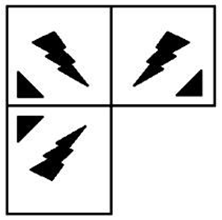Question
How many people are sitting between G and C when counted
in clockwise direction from G? Study the following information carefully and answer the given questions. A, B, C, D, E, F, G and H are sitting around a Square table such that two persons sit on each side, but not necessarily in the same order. Some of the people are facing the centre while some face outside. C sits second to the left of E. E faces the centre. F sits third to the right of C. G sits second to the left of H. G faces the same direction as D. Immediate neighbours of E and F face opposite directions (i.e., if one neighbour faces the centre the other neighbour faces outside and vice-versa). H doesn’t face towards the center. G sits opposite to C. D sits third to the right of B. E sits second to the left of B. Immediate neighbours of B face the same direction (i.e., if one neighbour faces the centre the other neighbour also faces the centre and vice-versa).Solution
C sits second to the left of E. E faces the centre. F sits third to the right of C. G sits second to the left of H. H doesn’t face towards the center. G sits opposite to C. If E sits at place no. 2, then C sits at place no. 8. If C faces the centre, then F sits at place no. 5. G sits at place no. 3. H will sit at place no. 1 and faces outside the centre. G faces the same direction as D. Immediate neighbours of E and F face opposite directions (i.e., if one neighbour faces the centre the other neighbour faces outside and vice-versa) D sits third to the right of B. E sits second to the left of B. Immediate neighbours of B face the same direction (i.e., if one neighbour faces the centre the other neighbour also faces the centre and vice-versa). B will sit at place no. 4 and faces the centre. D will sit at place no. 7. As Immediate neighbours of E and F face opposite directions (i.e., if one neighbour faces the centre the other neighbour faces outside and vice-versa). So, G will face inside the centre and I will also face the same direction as G. Only person left for place no. 6 is A and faces outside the centre. F will face the centre as immediate neighbours of B face the same direction (i.e., if one neighbour faces the centre the other neighbour also faces the centre and vice-versa).
Final arrangement as shown below:
A is the brother of B. B is the son of C. D is the wife of C. E is the sister of D. How is A related to E?
A paper is folded and cut as shown in the following figures. How would this paper look when unfolded?
In a certain code language, ‘STORY’ is coded as ‘97’ and ‘PULL’ is coded as ‘61’. How will ‘INCOME’ be coded in that language?
...In a certain code language, 'LAMP' is coded as 'IWJL'. What is the code for 'LOGS' in that code language?
Which of the following letter-clusters should replace # and % so that the pattern and relationship followed between the letter-cluster pair on the left ...
Four words have been given, out of which three are alike in some manner and one is different. Select the odd one.
Select the set in which the numbers are related in the same way as are the numbers of the following sets.
(NOTE: Operations should be performed o...
In the following question, three statements followed by three conclusions are given. Take the given statements to be true. Find which of the given concl...
Select the correct mirror image of the given figure when the mirror is placed at MN as shown below.
Question figure

Relevant for Exams:


